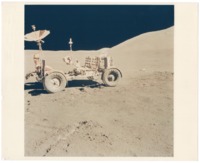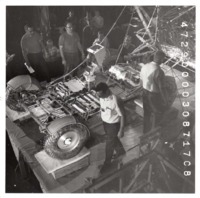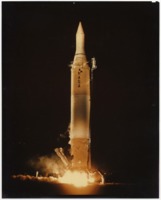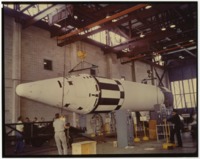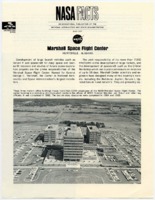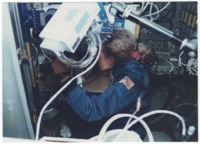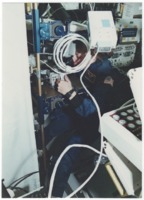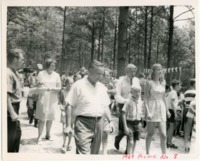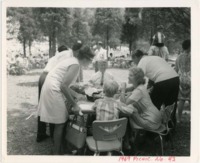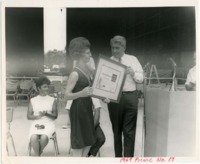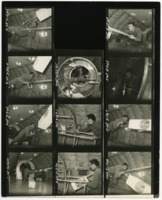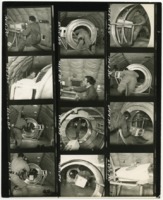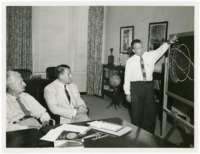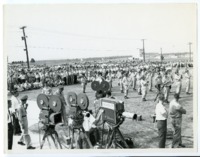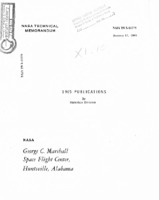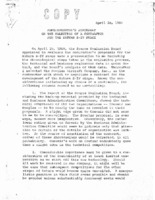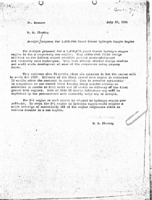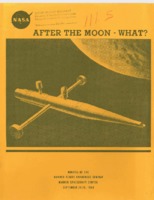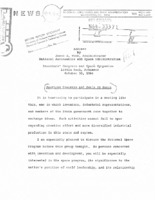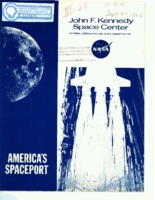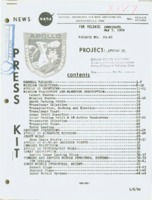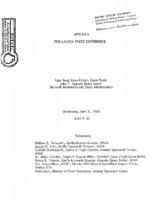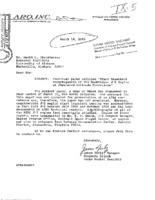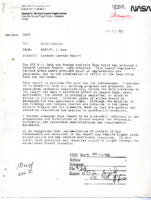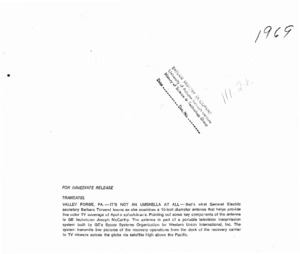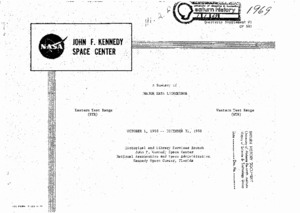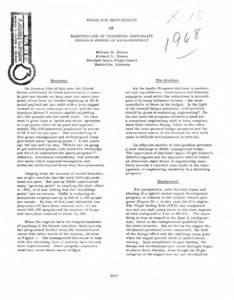
Browse Items (156 total)
Sort by:
-
The lunar roving vehicle (LRV) on the Moon.
This photo shows the LRV on the moon at the Hadley-Appenine mountain range landing site during the Apollo 15 mission. Developed by Marshall Space Flight Center and built by Boeing, the LRV was an electric vehicle used to explore the Moon's surface during the Apollo 15, 16, and 17 missions. -
The lunar roving vehicle (LRV) during its construction.
Developed by Marshall Space Flight Center and built by Boeing, the LRV was an electric vehicle used to explore the Moon's surface during the Apollo 15, 16, and 17 missions. -
Juno II launch.
Juno II was developed by the Army Ballistic Missile Agency in Huntsville, Alabama. -
NASA Facts leaflet on Marshall Space Flight Center.
The leaflet describes Marshall's role in developing launch vehicles for the space program, its collaboration with NASA facilities in Mississippi and Louisiana, and its research and development operations. Includes a map. -
Jan Davis working in the Space Habitation Module on Space Shuttle Discovery.
Davis served as a Mission Specialist on STS-60, the second flight of the Space Habitation Module (Spacehab). As part of the mission, she conducted thin-film crystal growth experiments in the Wake Shield Facility. -
Jan Davis working in the Space Habitation Module on Space Shuttle Discovery.
Davis served as a Mission Specialist on STS-60, the second flight of the Space Habitation Module (Spacehab). As part of the mission, she conducted thin-film crystal growth experiments in the Wake Shield Facility. -
Wernher von Braun with daughter Margrit and son Peter in the crowd at the 1969 MSFC employee picnic.
MSFC Director of Administration and Technical Services David H. Newby is shown in the foreground. -
Wernher von Braun presents an Award of Achievement to Jean Drake at the 1969 MSFC employee picnic.
Drake worked in the Safety Office. Lois Smith is shown seated at left. -
NASA personnel wait to greet President John F. Kennedy during his second visit to Huntsville.
Kennedy visited Huntsville on Armed Forces Day 1963. He first visited the area on September 11, 1962. -
Crowds and television cameras wait for President John F. Kennedy during his second visit to Huntsville.
Kennedy visited Huntsville on Armed Forces Day 1963. He first visited the area on September 11, 1962. -
"1965 Publications," Materials Division, George C. Marshall Space Flight Center.
This document is a compilation of abstracts of NASA Technical Memorandums and MSFC Internal Notes, written by personnel of the Materials Division and released during 1965. -
"After the Moon - What? Minutes of the Manned Flight Awareness Seminar."
The seminar was held at the Manned Spacecraft Center, September 25-26, 1969. -
"American Progress and Goals in Space," address by James E. Webb.
This address was given by James E. Webb, Administrator, National Aeronautics and Space Administration, at the Inventors' Congress and Space Symposium, Little Rock, Arkansas. -
"America's Spaceport."
Guide to John F. Kennedy Space Center, including an introduction from Center director Kurt Debus. -
Apollo 10 press kit.
The press kit includes documentation on the Command and Service Module, Lunar Module, Saturn V launch vehicle, astronauts, and mission descriptions. Release No. 69-68. -
"Apollo 6 Pre-Launch Press Conference."
The press conference was given at Cape Royal News Center in Cocoa Beach, Florida, on Wednesday, April 3, 1968, at 3:30 PM. Participants: William C. Schneider, Apollo Mission Director, NASA; George M. Low, Apollo Spacecraft Manager, NASA; Clifford Charlesworth, Apollo 6 Flight Director, Manned Spacecraft Center, NASA; Dr. Arthur Rudolph, Saturn V Program Office, Marshall Space Flight Center, NASA; Rocco A. Petrone, Apollo 6 Launch Director, Kennedy Space Center, NASA; Col. Royce Olson, USAF, Director DOD Manned Spaceflight Support Office, Patrick AFB; Chris Kraft, Director of Flight Operations, Manned Spacecraft Center. -
Bibliography of AEDC J-2 engine test reports.
Includes a letter to David L. Christensen, Research Institute, University of Alabama, Huntsville, Alabama from James Neely, dated March 18, 1969, with the subject line, "Technical paper entitled 'Start Transient Investigation of the Rocketdyne J-2 engine at Simulated Altitude Conditions.' " The bibliography of all AEDC J-2 engine test reports between July 1966 and Octoebr 1968 is attached. -
Interviews with Wernher von Braun conducted by Dr. Emme and T. Ray.
Interview with Dr. von Braun by Dr. Emme. Beginning of side 1 to 19:50. -
Interview with Dieter Grau.
Dieter Grau interviewed on failure analysis and management of Saturn program. Both sides of tape.Tags Oral History -
Interviews with Shields and Davenport (Rocketdyne?).
Interview with Davenport (0-23:44 S1) and Shields (23:44 S1 - end S2). Topics covered include the reliability of the F1 engine, Skylab, and electronic manufacturing.Tags Oral History -
Interviews with Sawyer and Kudebeh (Rocketdyne?).
Interviews with Sawyer (0 - 16:58 S1) and Kudebeh (16:58 S1 - end S2) on weight penalties, schedule/performance bonuses, and project management.Tags Oral History -
Interviews with Weidner and Neubert.
Side 1 is an interview with Weidner and Neubert on the testing of Saturn and the different design philosophies of various NASA groups.Tags Oral History -
Interview with Bauer.
Interview on the developments on Thor applied to the Saturn Program, structures, Welding, Machining of Part, and Insulation of the rocket. Both sides of tape.Tags Oral History -
Interview with Ed Mims.
Interview on the fuels involved in the Saturn as well as the transport and management of these fuels. Both sides of tape.Tags Oral History -
Interview with Schwartz (chief engineer?).
Interview on the development of Saturn engine design and control, as well as life at the Mississippi engine test site. Both sides of the tape.Tags Oral History -
Interview with Newell.
Interview on the Development of Saturn and the general design and management philospohy of NASA. One side of tape only.Tags Oral History -
Interview with H. Paul.
Interview with German engineer on engine design, propellants, thermodynamics, and design barriers and overcoming them. Both sides of tape.Tags Oral History -
Interviews with Fontaine and Attinello, Davenport, Rocketdyne.
Interview with Rocketdyne engineers on rocket engine design and stability. Both sides of tape.Tags Oral History -
Interview with G.A. Phelps (Seal Beach?).
Interview on Materials Management, Configuration Management, and Changes in Design. Full side of tape.Tags Oral History -
STS 51-L Data and Design Analysis Task Force Lessons Learned Report.
This report was produced by the Data and Design Analysis Task Force "to support the Presidential Commission appointed by President Ronald Reagan to investigate the loss of the Space Shuttle Challenger and its crew." The report includes details from investigations in the areas of Development and Production, Prelaunch Activities, Accident Analysis, and Mission Planning and Operations. The report includes a recommendation to conduct an investigation "into the manufacturing process, final delivery and material cutting of the O-rings" that failed during the accident. -
Transatel.
Description of the Transtel without accompanying photograph. -
"A summary of major NASA launchings" between October 1st and December 31st, 1968.
This is the first Quarterly Supplement to the October 1968 edition of GP 381, ''A Summary of Major NASA Launchings (Eastern Test Range and Western Test Range)." This Supplement covers the period from October 1 to December 31, 1968. Two additional Quarterly Supplements will be issued during 1969. Each of these will list those major NASA launchings occurring during the three-month period it covers. The basic publication will be revised and reissued, incorporating the information contained in the Supplements, as well as covering the final three-month period, subsequent to October 1, 1969. William A. Lockyer, Jr. -
"Space age management or maintenance of technical capability during a period of retrenchment."
On January 3Ist of this year the United States celebrated its tenth anniversary in Space. In just one decade we have seen our space program climb from an humble beginning (a 30.8-pound payload put into orbit with a jury-rigged rocket) to extra-vehicular-activity and the tremendous Saturn V vehicle capable, of putting 250,000 pounds into low earth orbit. We have seen it grow from a "quick and dirty" operation to a program which at its peak had approximately 380,000 industrial employees in excess of {dollar}5.O billion per year. The marshalling of this great management and technological team generated many "growing pains". A few years ago the hue and cry was, "Where are we going to get sufficient people with scientific knowledge and drive to implement the space program?" Industry, sometimes reluctantly, was pressed into tasks which required managerial and technical skills beyond those they then possessed.
